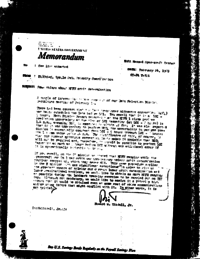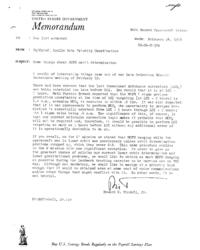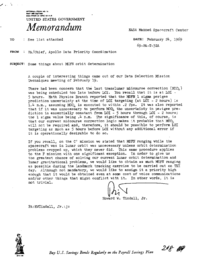See list attachedFebruary 24, 196969-PA-T-32APA/Chief, Apollo Data Priority CoordinationSome things about MSFN orbit determination
A couple of interesting things came out of our Data Selection Mission Techniques meeting of February 19.
There had been concern that the last translunar midcourse correction (MCC₄) was being scheduled too late before LOI. You recall that it is at LOI – 5 hours. Math Physics Branch reported that the MSFN 1 sigma perigee prediction uncertainty at the time of LOI targeting (at LOI – 2 hours) is 1.4 n.m., assuming MCC₄ is executed to within .2 fps. It was also reported that if it was unnecessary to perform MCC₄ the uncertainty in perigee pre- diction is essentially constant from LOI – 5 hours through LOI – 2 hours; the 1 sigma value being .4 n.m. The significance of this, of course, is that our current midcourse correction logic makes it probable that MCC₄ will not be required and, therefore, it should be possible to perform LOI targeting as much as 5 hours before LOI without any additional error if it is operationally desirable to do so.
If you recall, on the C' mission we stated that MSFN ranging while the spacecraft was in lunar orbit was unnecessary unless orbit determination problems cropped up, which they never did. This same procedure applies to the F mission with one significant exception. In order to give us the greatest chance of solving our current lunar orbit determination and lunar gravitational problems, we would like to obtain as much MSFN ranging as possible during the landmark tracking exercise to be carried out on TEI day. Although not mandatory, we would like to assign it a priority high enough that it would be obtained even at some cost of voice communications and/or other things that might conflict with it. In other words, it is not trivial.
- Feb 06, 1969 – F/G cis-lunar midcourse correction mission techniques (4.1σ)
- Nov 20, 1968 – Is MSFN ranging mandatory for C’? (3.2σ)



